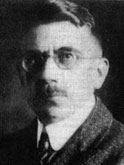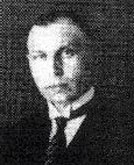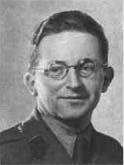The Enigma Machine
Its Construction, Operation and Complexity
|
|
|
|
|
|
|
Arthur Scherbius
Inventor
of Enigma
|
Hans-Thilo Schmidt
The spy codenamed ASCHE
|
Marian
Rejewski
Deduced
the rotor wiring
|
Henryk
Zygalski
Discovered
the
perforated sheet method
|
Jerzy
Růzycki
Discovered the
clock method
|
1. Brief Historical Background
Cryptography entered the machine age toward the end of World War I with the
invention of the rotary electro-mechanical enciphering machine. Shortly after
the end of World War I, Arthur Scherbius, a German inventor, developed and patented
such a machine for the commercial market. He called his machine Enigma.
Scherbius' Enigma, in a modified and improved form, was later used widely throughout
the German armed forces as the standard method of encrypting messages prior
to radio transmission.
In 1932, Poland's Biuro Szyfrow (Cipher Bureau) embarked on a determined effort
to break Enigma. They were assisted by documents passed to them by the French
stolen by Hans-Thilo Schmidt, an avaricious German cipher clerk with the chilling
codename ASCHE (Ashes). Schmidt was arrested, interrogated and shot for his
treachery in 1943.
At the Biuro Szyfrow, three brilliant cryptanalysts, Marian Rejewski, Henryk
Zygalski and Jerzy Rozicki, succeeded in breaking the Enigma in 1933. In one
of the greatest-ever feats of cryptanalysis, Rejewski deduced the internal wiring
of the Enigma's rotors and Umkehrwalze. Zygalski invented a cryptanalytical
method using perforated sheets which exploited the German procedural error of
repeating the encipherment of the message-setting. Růzycki devised the clock
method which was sometimes able to determine which of the Enigma's rotors was
in the fast position. The Poles invented two rotary electro-mechanical machines,
the cyclometer and the bomba, to assist in their work. The bomba (plural
bomby) appears to have been named after the ice cream by Jerzy Rozycki.
In 1939, the Germans increased the sophistication of Enigma which thwarted
further Polish attempts at cryptanalysis at that time. In July 1939, the Poles,
fearful of Germany, gave the secrets of their research to the British and the
French. The French made little progress but the British used the windfall to
great effect at the Government Code and Cipher School at Bletchley Park in Buckinghamshire,
which was to become the centre of Allied codebreaking.
At Bletchley Park, Enigma was initially broken by hand methods, but in August
1940, the first of about 200 British bombes, manufactured under the Cantab
tradename by the British Tabulating Machine Company in Letchworth, Hertfordshire,
was delivered to Bletchley Park.
The British bombe, which was designed by Alan Turing and Gordon Welchman, is
similar to the Polish bomba only in that both are rotary electro-mechanical
machines. They worked on entirely different cryptanalytical principles. The
Polish bomba's modus operandi was much more fragile than that of the
British bombe as it exploited the repeated encipherment of the message-setting,
an error which the Germans might eliminate at any time. In fact this is precisely
what occurred in May 1940 after which the Polish bomby and the perforated Zygalski
sheets were suddenly rendered useless.
Accordingly, the British bombe owes little to the Polish bomba. This is not
to belittle the immense Polish contribution to the Allied codebreaking effort
which owes a very great debt to the Poles, primarily for supplying the internal
wiring of the Enigma's rotors and for demonstrating that the Enigma could be
broken by a machine.
Throughout the war, the British bombes, assisted later in the war by the United
States Navy bombes, were the primary means of breaking Enigma traffic. The cornucopia
of information that they supplied made a major, and perhaps vital, contribution
to Allied victory.
ULTRA, the name applied to Allied intelligence obtained from cryptanalysis,
played an important role in many of the major battles in the European, Mediterranean
and Atlantic theatres, including, most critically of all, the Battle of the
Atlantic. Not all ULTRA was derived from Enigma traffic however. The high-grade
Geheimschreiber and SchlŁsselzusatz (STURGEON and TUNNY) cipher
machines which yielded the FISH traffic were broken on the Colossus series of
primitive electronic computers.
During the course of the war the Enigma underwent a number of design modifications
including the addition of a rotor. Consequently there were many different models
of the Enigma. The bombe was developed to mirror these modifications accordingly.
The following account describes the standard Army and Luftwaffe Enigma and the British bombe
which broke it.
Copyright © Graham Ellsbury 1998, 2003
Continue to Part 2. Description of the Enigma Machine
Return to The Enigma and the Bombe main page
Home




